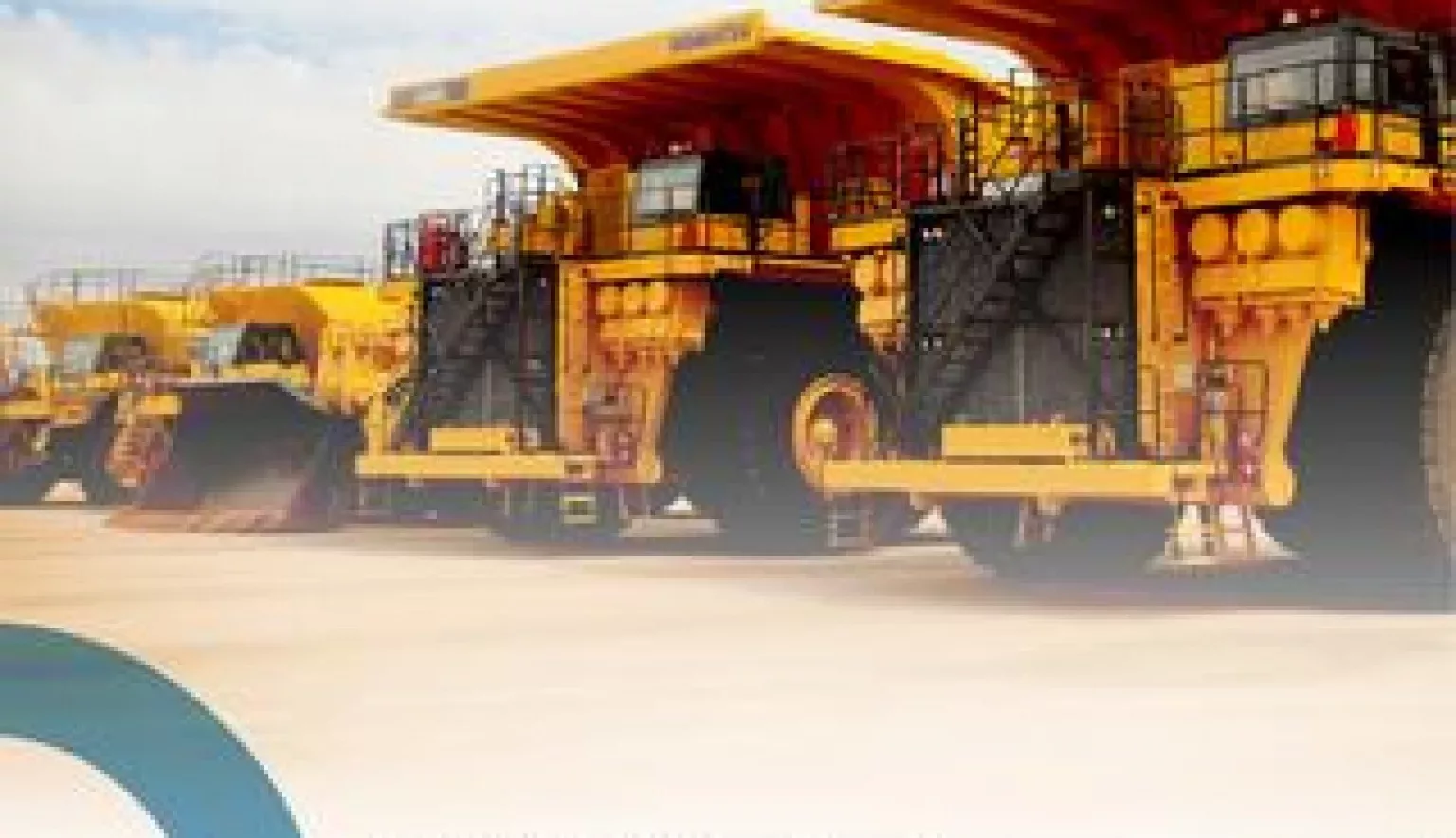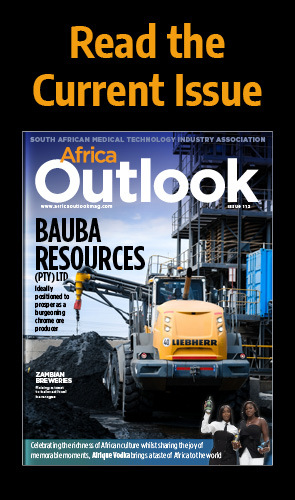Swakop Uranium is constructing and developing the Husab uranium mine, approximately 65km by road from the coastal town of Swakopmund in Namibia.
NAMIBIA’S URIANIUM GIANT
Swakop Uranium was established in 2006 to explore, evaluate, develop and produce uranium oxide as a source of fuel for low cost, environmentally-friendly, nuclear power. Swakop uranium has identified as its first task “to deliver to its shareholders and the Namibian nation one of the largest and most efficient uranium mines in the world,” says Swakop’s Director: Communications and Stakeholder relations, Grant Marais. Cementing its place as one of the largest resource drilling projects globally, Swakop uranium has completed over 800,000 metres (or 800km) of combined reverse circulation and diamond core drilling since April 2006.
The Husab area was targeted as an exploration area of interest in 2006- 07. The geological reasoning behind this was that similar rock formations to those hosting the Rössing Mine to the north were interpreted to be concealed beneath the desert plain in the northern part of Swakop uranium’s Exclusive Prospecting License (EPL). The discovery holes were drilled in late 2007, the chemical assay results for the three discovery holes were returned from the laboratory in early 2008 and released to the market in February 2008. Until April 2012, Swakop uranium was a 100% subsidiary of Extract Resources, an Australian company listed on the Australian, Canadian and Namibian stock exchanges. However, in April 2012, Taurus Minerals Limited of Hong Kong became the new owners following a successful takeover of Extract Resources.
At the end of June 2014, Swakop uranium moved its corporate head office from Windhoek to Swakopmund. The new offices, previously owned by Areva, will be referred to as the Husab Tower.
HUSAB URANIUM MINE PROJECT
Swakop Uranium is constructing and developing the Husab uranium mine, approximately 65km by road from the coastal town of Swakopmund in Namibia. The mine is planning first production by December 2015 and will reach nameplate production by 2017.
The Namibian government granted Swakop uranium a license on 30th November 2011 to develop the Husab mine, a project that will create about 1,584 permanent jobs and an additional 6,000 temporary jobs during construction. This will increase the number of people employed in the Namibian mining sector by approximately 17%. The project will furthermore create up to 16,000 indirect job opportunities as a result of the mining-multiplier effect.
The Husab project officially kicked off on 18th April 2013 with a groundbreaking ceremony on the mine site. Just over a year later, on 8th May 2014, the start of mining operations was declared officially open by the Namibian President, His Excellency Hifikepunye Pohamba.
On the previous day, the permanent road from the B2 transport route to the Husab mine was officially opened by Namibia’s Founding President, HE Dr Sam Nujoma. The road project included a 160m bridge over the Khan River, linking the mine to the main B2 transport route leading to Swakopmund. This is the longest bridge built in Namibia since the country’s independence in 1990. The surfaced road connecting the mine with the Namibian road network, stretches over 22km.
Swakop have received exceptional support in constructing roadways, water and power networks to the mining site. “Namibia is an investor friendly country which has a great attitude towards foreign investment and securing the technical skills required for the job,” says Marais. Husab is being developed as a low-risk, conventional, large-scale load-and-haul open pit mine, feeding ore to a conventional agitated acid leach process plant. The mine has a potential life of more than 20 years.
DEVELOPING NAMIBIAN INFRASTRUCTURE
Since the Husab project was officially approved in October 2012, Swakop Uranium has made signifi cant progress. Construction of the 37 hectare Husab contractors’ village is complete. The village is a showcase in Namibia, comparing well with the standards of mining companies around the world.
Before officiating at the Commencement of Mining Operations on 8th May, President Pohamba visited the Husab project construction village. He inspected the living quarters, the dining room, the kitchen, the ablution facilities and recreational areas. He also spoke to several of the residents in the village.
During his speech later in the day, he praised Swakop uranium on the excellent quality of the accommodation facilities in the village, where up to 4,000 workers will be housed during the life of the project. “The facilities are even better than some Windhoek hotels,” he said. He further encouraged workers to cherish the employment opportunities at the Husab project: “As a national workforce, Namibians should all focus on improving their productivity,” he said.
By the end of August 2014, the onsite project workforce stood at 3,500, of whom 87% were Namibian citizens. “Higher levels of Namibian citizens are targeted as we reach the production stages, as local human capital is important to us,” Marais adds.
Swakop Uranium has also confirmed plans to build a 500,000 tonne sulphuric acid plant at the mine. Sulphuric acid is a key chemical used to recover uranium in an ore body. Construction of the sulphuric acid plant will start in October 2014. The Husab mine is expected to utilise all the sulphuric acid produced at the envisaged plant. Additional acid, if needed, will be imported or sourced locally.
KOMATSU HAUL TRUCKS
Manufacturing and assembly of the massive Komatsu haul trucks that will be the primary movers of waste and ore on the Husab mine, is well in progress. The trucks, each with a payload of 327 tonnes, are delivered in a knocked down kit form to the Husab site, where they are being assembled. The tyres, which are 4m in diameter and weigh 5.3 tonnes each, are shipped from Japan as part of a supply agreement between Swakop uranium and Bridgestone. The first 11 trucks have been commissioned and handed over to the mining team. The next batch of 12 trucks will be handed over by the end of 2014. Swakop Uranium will use a fleet of 43 of these haul trucks, which will be the primary movers of waste and ore on the Husab mine.
The Husab mine has also put two ERS7495 electric rope shovels and two FS6060 hydraulic face shovels into operation. Swakop uranium will use three rope shovels in tandem with four hydraulic face shovels. The third units for both ERS7495 and FS6060 are currently being assembled.
Rope shovel assembly started in December 2013, while components for support equipment such as water trucks, dozers, graders and frontend loaders are arriving on site as planned. While the ERS7495 shovels will load between 105 and 110 tonnes per scoop, thereby filling a 327 tonne Komatsu haul truck in three loads, the FS6060 has one size bucket loading 62 tonnes. Each shovel takes 15 months to manufacture and deliver to site. Unlike the trucks, the shovel components are assembled into an operating shovel for the first time on site. The CAT rope shovel was the first shovel of that size and make that was assembled in Namibia by the Barloworld team. While hydraulic face shovels are mainly used for ore production and more precise mining capability, the rope shovels are used mainly for waste mining.
Four large le Tourneau front-end loaders and three drill rigs will also be used on the Husab mine. Drills typically take 12 months to manufacture and deliver to site. The drills arrive essentially complete and all that is assembled on site is the tall boom.
OPERATIONAL READINESS PROGRAMME
In the meantime, Swakop Uranium has started filling permanent positions well in advance of the opening of the mine as part of the Operational Readiness Programme. This will ensure that staff will be sufficiently trained and ready to hit the ground running.
To this end, Swakop Uranium has initiated a scholarship programme to reduce the skills shortage in various fields in the longer term, signing various agreements with Namibian universities. “Where possible, we will take students on for work experience and tours in order to develop the human population of the country,” Marais states. Moreover, Swakop uranium publically supports the Namibia Institute for Mining Technology (NIMT) and continues to assist in skills development for unemployed individuals.
Graduates will be afforded the opportunity to develop their skills and gain experience with Swakop uranium through a structured graduate training programme, thus providing the base to develop future leaders. To ensure development to a postgraduate level, the company will sponsor highly motivated and talented Namibians to study abroad and obtain postgraduate Master’s degrees at a university in China. Junior level employees will have specific training programmes to ensure upward mobility in the organisation.
The mining training programmes are on-going and progressing very well. Six simulators were delivered to site and are in full operation supporting the training programmes.
SHER POLICY
Safety is the most critical element to any construction or mining business and Swakop are proud to have completed approximately 3 million man hours without accident. “This reinforces the entire safety culture we have put in place. We would like our workers to go home in the exact same state they arrived at work. Our rigorous SHER safety programme ensures safety above all,” Marais highlights.
Environment and health are also equally as important to make sure that radiation levels remain at low levels. “Our Safety, Health, Environment and Radiation policy manages any and all aspects of safety in the workplace accordingly,” Marais comments.
“Mining is not just about extracting ore. For us, it is more important that we create a sustainable future for the area in which we are developing the Husab mine; in particular focusing on the socio-economic side of the business which we feel is in dire need of assistance.” As such, Swakop Uranium have put in place a sustainability programme that looks after the triple bottom line.
What’s interesting about the location of the Husab project is that it is built in the native area of the endangered Welwitschia plant. This 1,500 year old plant grows extremely slowly and is only present in parts of Namibia and Angola. Swakop Uranium have taken it upon themselves to preserve the plant as Marais further explains: “We want the environment to be as close to what it was before we were present here, to preserve these plants for the next generation. Consequently, we have invested significant resources in researching this plant and its root structures, placing a GPS point to the 50,000 we have discovered in the area; photographing each one and recording their state of health, gender and size. We have even moved roads to avoid disrupting the Welwitschia plants, and of course this is not just limited to preserving this one form of vegetation; it extends to all plants and trees in the area.”
WAGE AGREEMENT
Another highlight was the signing in September 2014 of a substantive agreement between Swakop Uranium and the Metal and Allied Workers Union of Namibia (MANWU) which covered contractors’ employees for the remainder of the Husab mine’s construction period.
According to the agreement, MANWU members working on the project will receive a wage increase. A fair negotiated settlement was reached on hourly pay rates for the contracting company’s employees which took all macro and micro economic factors into account.
According to Percy McCallum, Swakop Uranium’s Vice-President of Human Resources and Business Support, the negotiations with the employee representatives and MANWU represent a further step in a smart partnership between the parties. “This milestone is important to all parties as it ensures industrial peace and commitment from MANWU and contractors to build the Husab project on time thus ensuring completion of Namibia’s most significant project,” he added.
MANWU is committed to, and will support the contractors in improving productivity initiatives and encouraging MANWU members to refrain from being absent from work without permission or being guilty of poor timekeeping.
COMMUNITY INVOLVEMENT
Swakop Uranium firmly believes that the company’s reputation will not only be measured on their exploration, mining activities and contribution to the economy, but will be affected by the manner in which the company conduct themselves through interaction with the broader Namibian community and the environment. Swakop Uranium has therefore committed itself to social and empowerment aspects such as local procurement, local recruitment, involvement in social responsibility programmes, training, education and sound environmental management practices.
The Swakop Uranium Trust has furthermore identified some key areas of involvement which include training and education, environment, infrastructure, health and entrepreneurial development. These categories adequately deal with the three sustainability pillars of social, economic and environmental focus. Examples of CSI projects that are supported by the Swakop uranium Trust are Ellie’s vegetable garden in Arandis (the town nearest the Husab mine site) and the Tears of Hope Orphanage in Swakopmund. The Trust furthermore awards bursaries for promising Namibian university students on an annual basis and is supporting an initiative to encourage Namibian entrepreneurs to develop manufacturing businesses to support mine procurement.
In September 2013, the Swakop Uranium Foundation responded to the Namibian government’s call for assistance to thousands of drought victims in Namibia by donating an amount of N$100,000 to the government’s drought relief fund. In November 2013, Swakop uranium handed over a donation of N$100,000 to the President’s Charity Fund. This fund is a non-profit organisation established by His Excellency Hifikepunye Pohamba in 2012 with the aim of meeting government half-way in its efforts to alleviate poverty and provide quality education, especially among orphans and vulnerable children.
The company also assisted the Asser Kapere pre-primary school in Arandis, the town nearest to the Husab mine site, to build a wall around the school and fix the cracks in the classroom walls. The donation will also enable the school to buy basic educational material for the children.
Swakop Uranium attaches great importance to its goal of localisation in Namibia. “An example of our commitment to local suppliers is Ben Kahirimana of Office Experts, who have grown their businesses exponentially by offering core services to Swakop uranium and to the growing communities around them.” Marais speaks for the entire company when he surmises that Swakop uranium herald a great importance in developing the people of the Namibian region in a sustainable manner: “We are very proud of our achievements within both the community and the Husab mine project, and are committed to supporting the Namibian economy.”

































